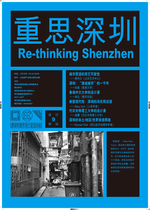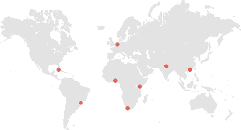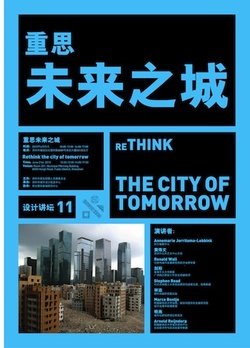INTI organized a series of public lectures on January 18 entitled Rethinking Shenzhen in the Shenzhen Urban Planning Bureau to discuss the urban challenges of Shenzhen and the first results of New New Towns.
Huang Weiwen (Director Shenzhen Center for Design), Juan Du (Director of Master of Architecture Program and Assistant Professor – Hong Kong University) and Mary Ann O’Donnell (Shenzhen Based Ethnographer) gave lectures about their long-term research on the planning history of Shenzhen. Ronald Wall (Economic Geographer – Institute for Housing and Urban Development Studies) presented the first outcome of his research on the local, regional and global Investment networks of Shenzhen. Furthermore, Qu Lei (Researcher, Chair of Spatial Planning and Strategy – Delft University of Technology) and Tat Lam (Director Urbanus Research Bureau) gave short presentations about the objectives and first proposals done by the students from the Delft University of Technology and the Chinese University of Hong Kong on the three research sites in Shenzhen.
A conference to conclude the first year of New New Towns in Shenzhen will take place on June 21 in the Shenzhen Urban Planning Bureau.
The public lectures were generously supported by the City of Almere and OCT LOFT.
Date public lectures: January 18, 2013
Location: Shenzhen Urban Planning Bureau, Shenzhen
program:
| 14.10 – 14.20: | Word of Welcome by Wang Youpeng (Deputy Secretary General of the Shenzhen Municipal Government) |
| 14.20 – 14.30: | Word of Welcome Michelle Provoost (Director International New Town Institute) |
| 14.30 – 14.40: | Introduction Linda Vlassenrood (Program Director New New Towns) |
Moderator: Linda Vlassenrood
Rethinking Shenzhen
| 14.40 – 15.10: | Huang Weiwen (Director Shenzhen Center for Design) The Possibilities of Alternative City Making |
| 15.10 – 15.20: | Intermezzo: Statement Design Workshop Guangming New Town |
| 15.20 – 15.50: | Juan Du (Director of Master of Architecture Program and Assistant Professor – Hong Kong University) Shenzhen: One Thousand Years of an "Instant City" |
| 15.50 – 16.00: | Intermezzo: Statement Tat Lam (Director Urbanus Research Bureau) Design Studio Chinese University Hong Kong |
| 16.00 – 16.15: | Coffee break |
| 16.15 – 16.45: | Mary Ann O’Donnell (Shenzhen Based Ethnographer) Repairing Modernity – Utopian Discourse in and around Shenzhen |
| 16.45 – 16.55: | Intermezzo: Statement Qu Lei (Researcher, Chair of Spatial Planning and Strategy – Delft University of Technology) Design Studio Delft University of Technology |
| 16.55 – 17.25: | Ronald Wall (Economic Geographer – Institute for Housing and Urban Development Studies) Local, Regional and Global Investment Networks of Shenzhen |
| 17.25 – 18.00: | Summary / Discussion moderated by Huang Weiwen |
The International New Town Institute (INTI) and the City of Almere, the Netherlands are celebrating one year of successful activities in Shenzhen, China. In 2012, INTI launched its international and multidisciplinary research program ’New New Towns. Why we need to rethink the city of tomorrow today’ in Shenzhen, China. INTI will present and evaluate the first results of the program on June 21 by organizing a conference at the Shenzhen Center for Design. Design professionals and tutors will elaborate on the city’s strengths and propose extraordinary alternative models for urban planning and concepts for economic growth. Mayor Annemarie Jorritsma will also attend and share her views on the future of Almere. At the conclusion of the conference, an agreement will be signed between the City of Almere and the City of Shenzhen to establish future cooperation in the field of sustainable urban development.
HOUSING NEEDS AND HOUSING PREFERENCES OF CREATIVE WORKERS IN SHENZHEN
Shenzhen wants to become a creative city. Policies to reach that goal are mainly aimed at providing attractive work locations, city marketing and organizing events. What has not been addressed is how to create attractive living environments for people working in the creative industries. Without providing good homes, attractive living environments and a good offer of amenities, creative companies may face difficulties to attract talented staff and Shenzhen may lose due to competition with other cities. So far, Shenzhen’s development has not sufficiently taken the residential preferences of creative workers into account. Large parts of the city were built for factory workers, next to large parts of the city being developed for higher income groups. Many creative workers, however, can be expected either in the middle-income categories, or (especially the starting creatives) in the lower income categories, where they often face the problem of not being eligible for public housing because of not having the right ‘hukou’. So far, the housing preferences and demands of creative workers in Shenzhen have not received much policy or research attention. For this research, creative workers have been interviewed about where they live, where they would like to live, and what the city of Shenzhen could do to improve their housing situation. The research is done in collaboration with architecture office Urbanus and links to their on-going work on Chinese creative cities.
− Huang Weiwen (Director Shenzhen Center for Design and Deputy Chief Planner, Urban Planning and Land Resource Commission of Shenzhen Municipality)
− Annemarie Jorritsma (Mayor of Almere)
GROWING GREEN CITIES
Mayor Jorritsma will shortly describe the history of the planning of Almere, from the reclamation of the land towards the execution of the garden city model in practice. This model was and remains the guiding line for the urban development of Almere. In the future the city will double in size and instead of making the existing areas dense new centers will be built, with the Almere Principles in mind. One example is the Floriade area, which will be built in the coming ten years in preparation for the 2022 World Expo on Horticulture Floriade. The World Expo will be held at the new city district Floriade, which will encompass a variety of innovative solutions to the rapid urbanization process. Feeding, Energyzing, Healthying and Greening are the central themes of the ten-year ‘Making of’ period and the World Expo. The international Growing Green Cities network is crucial for the development of these innovative solutions, which will be showcased at the Floriade.
− Tat Lam (Adjunct Assistant Professor, School of Architecture, Chinese University of Hong Kong – Director Urbanus Research Bureau)
MAKING NEW TOWNS IN NEW TOWN
BRIDGING THE PARADOXES OF HYPER-DENSITY AND LIVABILITY, MEGA-STRUCTURE AND GRANULARITY, RETRO-FUTURISM AND PRESERVATION
The primary case study presented here is Luohu and its current urban redevelopment projects. The main research focus was to identify the key features of the urban villages, industrial areas and commercial developments that should be maintained, cultivated, and built upon during the modernization process in order to make sure its history is not lost and its future is not cut-off. The current proposal under consideration by the city would increase the FAR of the new development areas from 4.5 to 9. Such rapid and brutal mega-scale development was claimed to be the only solution to compensate the extremely high financial loss from compensating the existing residents. Through his navigation of the planning approval process, the developer is enlisting two competing, but mutually compensating design proposals: one is recognized as defending and the other one is attacking. This lecture will evaluate the apparent appropriateness and efficacy of each, and understand the shifting feedback as the proposal transitions through the multi-layered bureaucracy of the governmental agencies charged with regulating the fabric of the city.
Although the ostensible answer is often “the whole”, the bitter truth is that such an approach is fundamentally impossible. While one may hope to somehow shrink-wrap the regeneration areas (including urban villages and industrial areas) and preserve them as a whole for future generations, unavoidably, the act of preservation is itself an act of change. An attempt to stop time is to turn the previously developed new town into an artifact, since change is the essence of Shenzhen. On the other hand, doing nothing in the face of generic redevelopment likewise ensures its extinction. Moreover, the research also analyzed different market forces and the will of the government to virtually guarantee full-scale modernization of each village site within the decade.
Lastly, the extreme conditions constraining those redevelopments (sky-high land-compensation rates, single-entity led development of massive tracts of land, and the financial necessity to double and triple urban density in already overcrowded neighborhoods) paradoxically create situations where the futurist paper mega-structures of 1960’s Europe not only find their first realistic opportunity to become manifest, but may be the best basis for rethinking the next iteration of the Urban Village: a component machine for mass-living within a national machine of production.
− Li Jinkui (Professor Institute of Urbanization – China Development Institute)
− Liu Heng (Adjunct Associate Professor, School of Architecture, Chinese University of Hong Kong – Principal NODE Architecture & Urbanism)
THE OTHER SHENZHEN
SEARCHING FOR IDENTITY OF DALANG, SHENZHEN
Shenzhen is a unique city, not because of its history, but because it lacks history. Thanks to its special geo-political location, such a lack has created its own history of uniqueness, and it has turned out to be a miracle in only thirty years’ time. Shenzhen has become an icon of Modern China.
However, behind the grand, glorious and glamorous side of Shenzhen, there is the other Shenzhen that we try to understand and accept: messy, chaotic, fragmented and not significant to the facial value of Shenzhen. Dalang is a representative of “The Other”. Dalang is a typical “The Other”, or we shall call it, “Generic City”, not because of its absence of history, but because it thinks its own unique history has no value. Dalang has tried very hard to be like others. It has become an instant city and global village with no identity, as a parasite of speedy urbanization of significant Shenzhen.
The focus of my MArch studio this spring at CUHK is to redefine a new and better identity for Dalang through design. But what exactly is meant by “new, better and different”, and better for “whom”? The point of departure for such design intervention on identity is to recognize an almost disappearing natural, cultural and social infrastructure, and an accumulated value of the place. Urban design and architecture are used as a tool to investigate the limits and capacities of the city, to explore new social and cultural relations and to search for a morphological expression of a social innovative system for the not-so-far future of Dalang. Several research-based design projects by our CUHK students will be introduced as the implementations of our value and belief in City and Urbanism are realized.
− Stephen Read (Associate Professor, Chair of Spatial Planning and Strategy – Delft University of Technology)
SHENZHEN SCENARIOS
Students of the MSc program in Urbanism at the TU Delft have participated in the studio ‘Shenzhen Scenarios’ as part of an INTI-led international research project on ‘New New Towns’. They explored development processes in Shenzhen with the aim of tackling some of the contradictions linked with rapid urbanization, migration, and policy focusing too exclusively on the economic side of development. Students focused less on the production of strategic plans and more on locally based studies of the dynamics of urban socio-spatial development (Friedmann 2004). This was done in order to better understand the processes that currently constitute development and to intervene in these processes in ways that tackle the contradictions. They focused on development as a heterogeneous process with innovative social, cultural, and spatial developments accompanying, and necessary to, economic development. They also raised the issue of the necessary presence of the past in any process of social and spatial change. The presentation will be a preliminary assessment of the results focusing on the way we differentiate and spatially organize different processes, and on the roles of stakeholders and local governance structures in any solution to problems of urban development.
− Arnold Reijndorp (Professor of Social-economic and Spatial Development of New Urban Areas, Centre for Urban Studies – University of Amsterdam)
TRANSITION FROM WORLD FACTORY TO WORLD CITY
EXPLORING SOCIO-ECONOMIC AND SPATIAL DEVELOPMENTS IN SHENZHEN
Shenzhen is changing from the world’s largest factory to a World City, with a more differentiated economy, diverse population and attractive environment. This is no longer a governance policy, but a new reality coming into existence. In the past six months ten master students of the University of Amsterdam explored social-economic and spatial changes that can be seen as the germs of the ongoing transition. The Urban Geography and Spatial Planning students researched very different subjects and places. Ranging from the background and ambitions of young migrants in Dalang with respect to their leisure time to alternatives for the planning process of the redevelopment of Baishizou urban village; from the activities in public space of young middle class families in high rise to the desires of a growing number of higher educated young migrant workers in an urban village like Baishizou; and from the conditions for the development of creative environments and the transformation of desolate factories to the role of architecture as a producer of ‘identifiers’ in a fast growing and apparently non-descript new city, such as Shenzhen. These explorations clearly show that the transition Shenzhen is aiming for is under way and in a pace faster than academic research can master. Much of what is reported in academic journals is already outdated. The discussion on migrant workers and the population of urban villages is an example and need to be revised. This can be of importance to the implementation of alternative strategies for the redevelopment of both urban villages and desolate factory buildings and sites. The social ambitions of the young middle class families and their aspirations in upbringing their child(ren) could have consequences for the concept and the design of public domain and collective space.
− Ronald Wall (Economic Geographer – Institute for Housing and Urban Development Studies)
SHENZHEN II: SPECIAL GREEN ECONOMIC ZONE
Through foreign investment, Shenzhen, once a small village, has rapidly transformed into one of the world’s fastest growing cities. Through the policy of “reform and opening” and the establishment of Special Economic Zones (SEZ) in 1979, Shenzhen SEZ has become a powerful recipient of foreign owned and joint ventures, particularly in the manufacturing industries. In recent years, many of Shenzhen’s manufacturing industries have shifted to inland less-costly cities. The increasingly vacant parts of Shenzhen’s require new economic transformations. Related to this, Shenzhen’s residents also need an improved quality of urban life.
In this presentation, it will be discussed how Shenzhen can transform into a more resilient “green” economy. This requires Shenzhen to start to develop urban conditions and urban policies that attract foreign and local investments in sustainable industries like renewable energy, biotech, creative sectors, and services. Based on a database of investments between cities worldwide, it will be shown which sustainable industries are potentials for Shenzhen, which competitor cities are already strong in these industries, and which urban factors underlie these strengths. Based on this knowledge, a proposal will be made for a future urban planning / design studio, in which these new industries can be researched and developed further for Shenzhen.
Moderator:
Linda Vlassenrood, Program Director International New Town Institute





